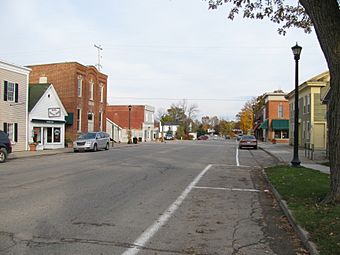Hegel Road Historic District facts for kids
Quick facts for kids |
|
|
Hegel Road Historic District
|
|
 |
|
| Location | Hegel Rd. between Seneca and the Goodrich Millpond, Goodrich, Michigan |
|---|---|
| Area | 5.4 acres (2.2 ha) |
| Architectural style | Greek Revival, Queen Anne |
| MPS | Genesee County MRA |
| NRHP reference No. | 82000511 |
| Added to NRHP | November 26, 1982 |
The Hegel Road Historic District is a special area in Goodrich, Michigan. It's a mix of old shops and homes located along Hegel Road. This area is important because it shows what the town looked like a long time ago. It was added to the National Register of Historic Places in 1982, which means it's officially recognized as a historic site.
Contents
The Story of Goodrich and Hegel Road
The history of Goodrich began in 1835. A man named Levi H. Goodrich and two of his sons, Enos and Moses, moved from New York. They bought a large piece of land, about 1,000 acres, near a creek.
Building the Town
More family members and neighbors joined them in 1836. The Goodrich brothers then built a dam and a sawmill around 1836 or 1837. A sawmill is a place where logs are cut into lumber. The town of Goodrich started to grow around this millpond. The first wooden homes, stores, and an inn were built in what is now the historic district. The inn, called the Goodrich House, is still there today!
In 1844, a gristmill was built. A gristmill grinds grain into flour. This made Goodrich an important place for farmers in the area to process their crops. The village grew slowly through the late 1800s. It became a stop for stagecoaches and added small factories.
Community Growth
In 1877, a group of women in the village started the Goodrich Ladies' Library Association. They bought a building on Main Street for their library. This shows how important reading and learning were to the community. Later, in 1893, a town hall was built. This building was used for town meetings and local government.
Changes Over Time
As the 1900s began, Goodrich continued to grow slowly. A new part of town was planned after a railway line was built nearby in 1900. In 1916, a fire destroyed some wooden buildings on Main Street. But new brick shops were built in their place. Even with these changes, the main part of the village still looks much like it did over 100 years ago.
What You'll See in the District
The Hegel Road Historic District covers two blocks of Hegel Road. This area was the original center of Goodrich. There are twenty buildings in the district, and seventeen of them are considered historic. These buildings help show the old character of the area.
Types of Buildings
Out of the twenty buildings:
- Ten are homes where people live.
- Four are public buildings, like two libraries, a post office, and a fire station.
- Six are commercial buildings, which means they were once shops or businesses.
The buildings are made from different materials. Some of the old shops are one-story and made of wood. Other commercial buildings are made of brick and have simple decorations. The homes in the district show different styles of architecture. You can see Greek Revival homes, which look a bit like old Greek temples. There are also Queen Anne homes, which often have towers and fancy details. Some homes are bungalows, which are smaller, cozy houses.
Important Buildings to See
Here are some of the most important buildings in the district:
- Goodrich Ladies' Library: This building was first a home. In 1883, the Ladies' Library Association bought it and turned it into a library. Part of the building was damaged by fire in 1903, but the remaining half is still there. It's a one-and-a-half-story wooden building with a pointed roof.
- Atlas Town Hall: This town hall was built in 1893. It's a two-story brick building with a Victorian style. Victorian buildings often have interesting shapes and decorative details.
- Goodrich House: Built around 1846, the Goodrich House is one of the oldest buildings in the district. It used to be a saloon and a place for travelers to stay overnight. It's a two-story wooden building shaped like an "L" and is in the Greek Revival style.

